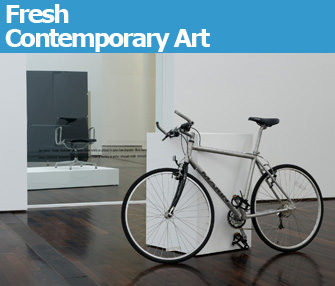 |
|
For “Work, Made-ready, Kunsthalle, Bern” (1996), Simon Starling turned a Charles Eames “Aluminum Group” chair into a Marin Sausalito bike and vice versa. Photo © Marc Domage |
MAC/VAL (Musée d’Art Contemporain du Val-de-Marne) may be a short trek from Paris, but it is a great destination for art lovers who want to stay on top of what’s going on right now in the art world. The museum …
 |
|
For “Work, Made-ready, Kunsthalle, Bern” (1996), Simon Starling turned a Charles Eames “Aluminum Group” chair into a Marin Sausalito bike and vice versa. Photo © Marc Domage |
MAC/VAL (Musée d’Art Contemporain du Val-de-Marne) may be something of a trek from Paris, but it is a great destination for art lovers who want to stay on top of what’s going on right now in the art world. The museum keeps its art contemporary through direct relationships with artists, who are invited to organize shows of their own work, so while much of the permanent collection dates from the 1990s and early 2000s, plenty of work made this year is also on show.
The large indoor and outdoor spaces offer plenty of room to display outsized – and sometimes difficult – works to their best advantage. Since much contemporary art requires that we understand what the artist was doing, or trying to do, the museum helps out with leaflets in French and English, didactic panels on the walls and labels for each piece. Labels from the previous show have been scored through to show they are no longer relevant, but left on view as part of the current trend for literal kind of “honesty” in art presentation.
MAC/VAL is currently holding two temporary exhibitions, both running through December 27: “Thereherethenthere,” a fascinating show of work by the Turner prize-winning English artist Simon Starling, and “La Mémoire du Vent,” drawings made with the help of the wind by Bernard Moninot.
MAC-VAL’s collaboration with Starling began in 2007. In this latest exhibition, he explores creation and re-creation in a piece called “Three White Desks” (2008-09): a desk dating from 1932 is re-created by a German cabinetmaker, whose only reference is a scan of a vintage print; the new desk is in turn photographed, and the image is transmitted by mobile phone to an Australian cabinetmaker, who makes her own interpretation of the desk. Then a jpeg of that desk is e-mailed to a cabinetmaker in London to produce a copy of a copy of a copy of the original. The show presents the development of the project as well as the original works by each craftsman.
For another piece, “Work, Made-ready, for Kunsthalle, Bern” (1996), a Charles Eames “Aluminum Group” chair is remade using metal from a Marin Sausalito bicycle, while the bike is re-created using the metal from the chair.
The most eye-opening of Starling’s works is “Silver Particle/Bronze (After Henry Moore)” (2008), in which a tiny silver particle is removed from the silver gelatin print of a photograph of one of Moore’s works and scanned in an electron microscope to create a 3D image, which is then hugely magnified and cast in bronze by a foundry that was used by Moore himself. We can well wonder if the result – a large re-creation in bronze of a tiny speck of silver – really has anything to do with Henry Moore. And so Starling takes us round and round while giving us new objects and ideas to consider.
Bernard Moninot uses petri dishes blackened with soot to capture the traces left by leaves or blades of grass as they flutter in the wind; these delicate drawings are then projected onto walls to offer what the artist calls “memories of the wind,” and that is all they seem to be.
In a section of the permanent collection called “Je Reviendrai” (“I’ll Be Back”), visitors can see Cecile Paris’s enchanting videos, which follow individuals in simple but odd actions with musical accompaniment. One, “Bianca” (2002), shows a youth skateboarding along a country lane at night, seemingly pursued by the camera/viewer and then running off into the night.
MAC/VAL is also showing two works by the talented sculptor/installation artist Tatiana Trouvé (another piece is on show in the Elles exhibition at the Centre Pompidou). One is a miniature elevator (“Expansion of a Closure Step 1,” 2007), with the light on and the doors open; it doesn’t have any moving parts, but as you bend down to peer inside, you sense the claustrophobia some people suffer in elevators. Another piece consists of three doors in the museum walls with lights inside the rooms they lead to. Only two can be opened to allow us to look inside; the other is locked, provoking thoughts of mystery, exclusion, protection or imprisonment.
MAC/VAL is full of surprises and well worth the trip. Plenty of friendly staff members are on hand to point you where you want to go. And it is not as far away as it seems: it took me less than an hour door-to-door to get there from Paris’s 10th arrondissement.
MAC/VAL: Place de la Libération, 94404 Vitry-sur-Seine. Métro: Porte de Choisy, then bus 183 (get off at the MAC/VAL stop). Tel.: 01 43 91 64 20. Open Tuesday-Sunday, noon-7 p.m., Thursday until 9 p.m. Admission: €5. www.macval.fr
Buy related books and films from the Paris Update store.
More reviews of Paris art shows.
Reader Reaction
Click here to respond to this article (your response may be published on this page and is subject to editing).
© 2009 Paris Update
Favorite